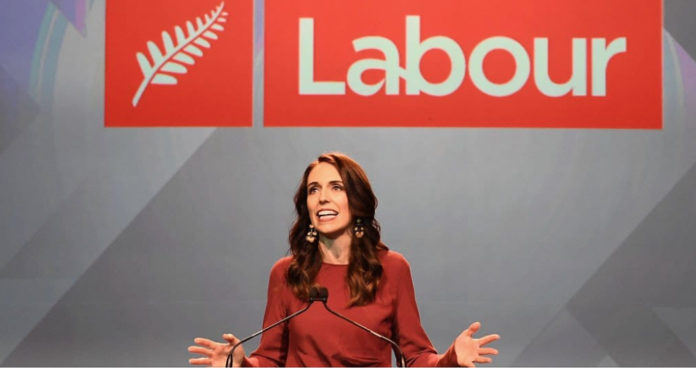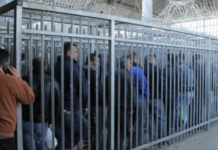Jacinda Ardern has just won a landslide victory in the 2020 New Zealand general election, securing the Labour Party’s highest share of the vote in any election since 1946, as well as the first ever outright majority government since proportional representation was introduced to NZ in 1996. This is an historic result for the party, a huge vote of confidence in Ardern’s crisis management skills, and in particular an endorsement of her government’s hugely successful Covid-19 elimination strategy.
What can we expect from this second-term Labour government, which is now free from the excuse of obstruction by its former coalition partner NZ First? Will they finally deliver on their ambitious rhetoric when it comes to housing, inequality and climate change? And what next for the working class movement and the radical left?
Come along to Socialist Aotearoa’s public meeting this Thursday to discuss these questions with socialists and trade unionists.
WHEN: Thursday 22 October
WHERE: Unite Union — 6a Western Springs Ave, Morningside






Business as usual inevitably leads to disasters.
About the connection between the coronavirus and the climate crisis, the interest of workers in the protection of wild animals and “ecological Leninism”.
Translated and modified excerpts of a conversation with Andreas Malm, Human Ecologist, Sweden, author of several books on climate change.
If we take the corona crisis seriously as a zoonosis, i.e. SARS-CoV-2 jumped from wild animals to humans, it is a symptom of the ecological crisis. When our economies destroy the habitats of wild animals, the viruses pour in to us. If we left nature alone, it would not cause that trouble. But capitalist corporations are wiping out the habitats in order to create more pastureland and plantations, extract oil and other raw materials, hunt animals and feed them into the wildlife trade.
These are some of the ways people can come into contact with viruses.
The trend towards more zoonotic infections is not as linear as that of increasing average temperatures. Nevertheless, they are comparable. Global disease and global warming are parallel developments and two elements of the ecological crisis. They also encourage one another in many ways. The deforestation of primeval forests, for example, is the main reason for the spread of zoonotic diseases and at the same time the second most important for increasing CO2 emissions. Higher temperatures, in turn, cause animals to migrate to areas with tolerable climatic conditions, increasing the risk of viruses spreading in the new areas.
The corona crisis should perhaps be compared to a catastrophic climate event, such as the recent wildfires in the USA. The two underlying development trends are of secular origin and interrelated. All indicators indicate that more pandemics, heat waves, wildfires, hurricanes and so on will follow in the future.
“Business as usual” inevitably leads to expansion of these catastrophes.
One of the biggest problems in the Corona19 discussion is that the ecological dimension, that is to say the socio-economic causes of the crisis, have been completely left out. This contradicts the situation in 2018, when heat waves, droughts and wildfires were relatively quickly linked to climate change in the media and political debates. By then, however, climate scientists and movements had created awareness for three decades to recognize this connection.
There is nothing similar in the field of zoonotic diseases. The scientific community is much smaller and weaker. The topic was not brought into the public eye by any movement. Hence, people tend to think of the coronavirus as a bolt from the blue, to be interpreted as an inexplicable event with no socio-economic causes (or consequences).
As with the climate crisis, the action of deeper socio-economic forces has destroyed wild nature, thereby releasing viruses that were previously enclosed in nature. So where do these forces come from?
If you look at deforestation, you come across the steadily growing role of consumption everywhere, driven by the global north. The import of beef, soybeans, palm oil, coffee and chocolate is fueling deforestation in the tropics.
The corona crisis also shows that industrial animal husbandry is a major driving force behind the destruction of habitats of wild animals that carry viruses that are potentially dangerous for humans. Should we take the corona zoonosis as an opportunity to raise the animal question louder in an anti-capitalist class struggle?
This is certainly required. But the everyday interests of the working class in the industrialized part of the world, even in tropical zoonotic states like Malaysia or the Congo are not directly identical to the needs of wild animals. A number of mediations are required to reconcile the two. One could argue that workers always bear the brunt of infectious diseases. They care for the sick, lose their jobs, fall ill or die.
Hence, they have an objective interest in ending the extinction of the wildlife that is causing the epidemics. But this realization does not arise spontaneously in the factory. It does not emerge from the struggles over wages or working hours, from campaigns for jobs and accommodation.
In Leninist categories one could say that the trade unionist consciousness is not enough to fight the class struggle against the sixth mass extinction (scientific count of the development of life on planet earth) into working class politics. The consciousness must be very advanced in these organizations. But we have not come close to that level because the working class has suffered enormous political setbacks over the last half century and in many places has even lost the ability to defend its direct interests.
It is simply not possible for governments in developed capitalist states to shut down their economies for months or years. The initial measures were so drastic that they had to be limited in time. Otherwise they would have required a clear break with normal operations. However, the initial reactions were quite radical, compared to the normal level of government market intervention. This can partly be explained by the fact that the coronavirus hit the ruling classes differently than the consequences of other socio-ecological contradictions.
There are now a number of right-wing populist figures who are sick with Covid-19: Trump, Johnson, Bolsonaro and so on. Of course, that does not mean that they are now taking militant action against the pandemic and its drivers. It will be interesting to see if the US state apparatus, if Trump continues to lead it, will hold its line as the virus works its way up in the society. It is quite possible that the intensity of lockdowns and restrictions will vary in the future as the virus continues to circulate and mutate.
A worrying result of the prevailing corona policy is that it has accelerated the economic decline of part of the petty bourgeoisie and fueled the so-called anti-corona demonstrations. At the same time, fascists and the new right have increasingly participated in these protests, while the left has hardly developed its own and recognizable corona policy as a class policy.
One problem is that, with the exception of Sweden, the left appears to be in favor of lockdown. In my opinion, lockdown is a pretty shitty thing. The climate movement has actually committed suicide, at least in the short term, by accepting it. It cannot stay that way.
If the pandemic continues in 2021, which is not unlikely, we cannot waste the year as recluses in front of our screens. The climate emergency does not allow us that.
The social force that made an impact this year was Black Lives Matter and the broader anti-racist movement. They have effectively violated the lockdowns without, of course, advocating an “anti-corona” or “anti-lockdown” position. If we transfer this attitude, it means: we have to get millions onto the streets to stop the forces behind the crisis.
The message has to be: you don’t want to live in lockdown? Hell, yeah, it’s awful. But there will be an endless series of pandemics if everything goes on as usual. So, let us take to the streets and demand an end to overconsumption and social control over the production that causes deforestation.
A climate movement that obediently obeys lockdowns to the point of abolishing itself is helping to maintain the status quo. If she is concerned about the pandemic, she should make the fight against deforestation her cause and get back on the streets.
It would have been best if she had already done so in March. We have now lost valuable time. We have to go back to the streets, to the opencast mines, to the automobile shows, to the SUVs. Fortunately, there are some signs of reactivation. But we are still a long way from regaining the initiative.
The best way would be to provide the climate movement with a program that combats the root causes of zoonoses.
This is a simple strategic orientation. Every consequence of the ecological collapse, be it a pandemic, a wildfire, a devastating storm or another extreme weather event, must be turned into a crisis for the forces that are responsible for the collapse.
An analogy is how Lenin saw World War I and how he dealt with it. He saw it as a manifestation of imperialism about to be turned into a revolutionary crisis. All forces ordered to go to war should be directed against the forces that produced the catastrophe. Without this essential Leninist step, we are doomed to endure ever worse and mutually reinforcing disasters.
The challenge is to use crisis symptoms such as Covid-19 or the wildfires on the Pacific coast of the USA to attack normal operations. We had some successes in summer 2018 with Greta Thunberg, the school strikes for the climate, protests from “Extinction Rebellion”, increased climate camps and so on. But we have to expand the attacks significantly.
A second transferable lesson from Lenin is that he emphasizes the urgency of action. Lenin pursued a policy of impatience, restless action in disastrous developments. He often argued that no time is to be wasted if the war disaster is not to worsen. And of course he was right. We need exactly this sense of urgency in contradiction to social democratic gradualism, according to which we would have time to take small reform steps.
Wouldn’t Lenin also be a valuable source from which to debate the question of organization anew today? In particular, since grassroots movements are often not necessarily better able to assert the interests of the subordinate classes?
Yes, we can learn a lot from Lenin’s criticism of the short-lived attempts at horizontal organization in late Tsarist Russia. Like how mass movements arise spontaneously and then collapse when there is no solid, uniform organization that keeps movements alive and gives them a direction. Of course, this does not mean that we have to adopt all the organizational principles as few of us live in conditions comparable to tsarist despotism.
But the pendulum on the organizational question has definitely swung too far in the direction of horizontalism and spontaneousism in the last few decades.
The left has to learn again to train cadres.
If any subject out there wanted to tackle the climate catastrophe and pandemic at the root, it would have to take strict measures. Regulation, expropriation, planning would be necessary to reverse deforestation and CO2 accumulation.
Any government willing to tackle the current disasters must take such steps.
We have nothing like that, not even close. We have a climate movement that is just flinging, weakened by the pandemic, full of contradictions and limitations. She shoulders an enormous historical burden.
So the more important and pressing question would be: how can the climate movement and its allies get the state to do what needs to be done?
Build Houses? Reduce Poverty maybe? What they promised in 2017, maybe?
Comments are closed.